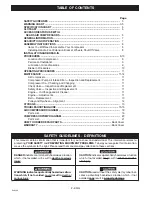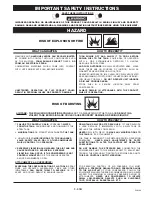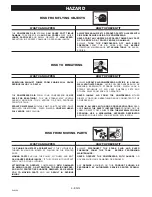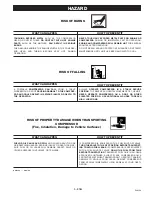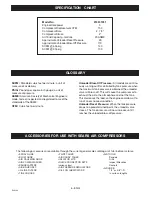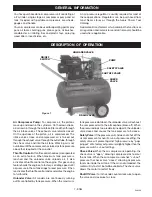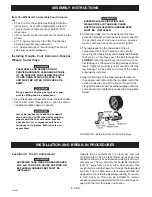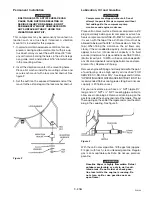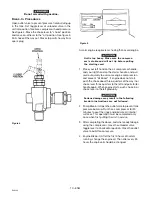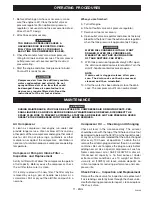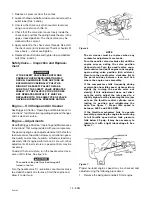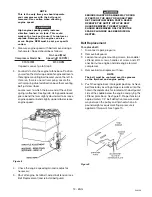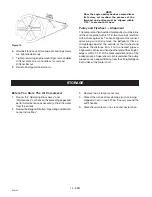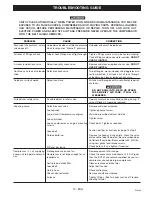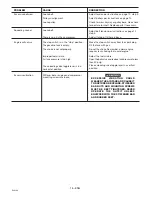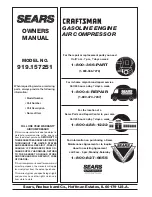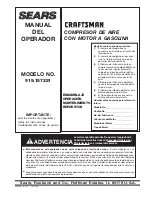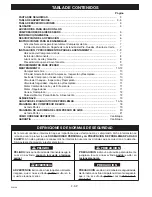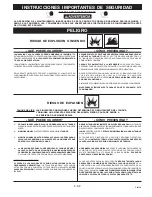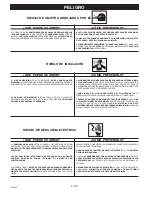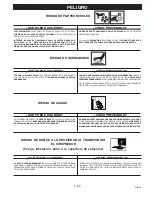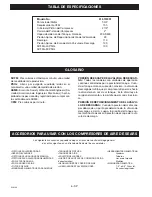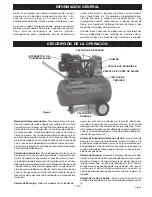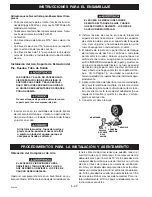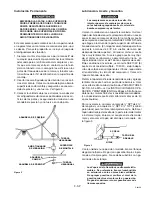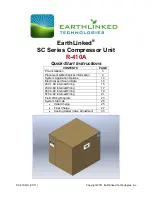
11 - ENG
D20396
1. Before attaching an air hose or accessory, make
sure the engine is off. Close the outlet valve or
pressure regulator. (If an optional air pressure
regulator is not used, do not use accessories rated
at less than 110 psig.)
2. Attach hose and accessory.
TOO MUCH AIR PRESSURE CAUSES A
HAZARDOUS RISK OF BURSTING. CARE-
FULLY FOLLOW STEPS 3 THROUGH 10
EACH TIME THE COMPRESSOR IS USED.
3. Check the manufacturer's maximum pressure
rating for air tools and accessories.
The compressor
outlet pressure must never exceed the maximum
pressure rating.
4. Start the engine and allow tank pressure to build.
Your outfit is ready for use.
Compressed air from the outfit may contain
water condensation and oil mist. Do not
spray unfiltered air at an item that could
be damaged. Some air operated tools or
devices may require filtered air. Read the
instructions for the air tool or device.
When you are finished:
5. Turn off engine.
6. Shut-off outlet valve or air pressure regulator.
7. Remove air tool or accessory.
8. Open outlet valve or regulator and allow air to slowly
bleed from the tank. Close the outlet vavle or regulator
when the tank pressure is approximately 20 psig.
WATER WILL CONDENSE IN TANK. IF NOT
DRAINED, WATER WILL CORRODE AND
WEAKEN THE AIR TANK CAUSING A RISK
OF TANK RUPTURE. SEE STEP 9.
9.
With tank pressure at approximately 20 PSI, open
the drain cock and allow moisture to drain. Turn the
drain T-handle counterclockwise to open.
NOTE
If drain cock is clogged, release all air pres-
sure. The drain cock can then be removed,
cleaned, and then reinstalled.
10. After the water has been drained, close the drain
cock. The compressor outfit can now be stored.
DURING MAINTENANCE, YOU COULD BE EXPOSED TO COMPRESSED AIR OR MOVING PARTS. PER-
SONAL INJURIES CAN OCCUR. BEFORE DOING ANY MAINTENANCE OR REPAIR, DISCONNECT THE
SPARK PLUG WIRE TO PREVENT ACCIDENTAL STARTING, AND RELIEVE AIR TANK PRESSURE. NEVER
OPERATE THE COMPRESSOR WITH THE BELT GUARD REMOVED.
Air Compressor
A clean air compressor and engine run cooler and
provide longer service. Clean or blow off fins and any
other parts of the air compressor and engine that collect
dust or dirt. Do not place rags, containers or other
material on or against the compressor. Ventilation is
necessary to maintain proper air compressor operating
temperature.
Compressor Pump Air Intake Filter —
Inspection and Replacement
A dirty air filter will not allow the compressor to operate
at full capacity. Before you use the compressor, check
the air filter to be sure it is clean.
If it is dirty, replace with a new filter. The filter may be
removed by using a pair of needle nose pliers or a
screwdriver. Pull or pry out the old filter and push in a
new one.
Compressor Oil — Checking and Changing
Check oil level in the crankcase daily. The oil level
should be even with the top of the fill hole and must not
be allowed to be lower than 3/8" from the top (6 threads)
at any time. It is recommended that the oil be changed
after every 100 hours of operation. To drain the oil,
remove the oil drain plug and collect the oil in a suitable
container. Be sure to replace the plug securely before
adding new oil. Use a special compressor oil such as
Sears compressor oil or SAE 20-20W SF motor oil.
(Crankcase oil capacity is 16 fluid ounces.) Under
extreme winter conditions use 10 weight oil. Multi-
viscosity oil (10W30) will leave carbon deposits on
critical components reducing performance and com-
pressor life.
Check Valve — Inspection and Replacement
Remove the check valve for inspection or replacement
if air is leaking constantly back through the check valve.
Use the following procedure to inspect, clean or replace
the check valve.
OPERATING PROCEDURES
MAINTENANCE


